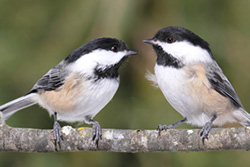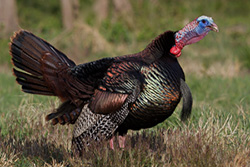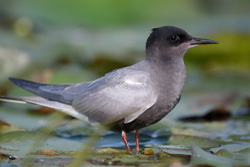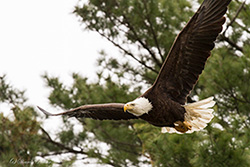Home → Fish & Wildlife → Wildlife → Species Information → Birds
Birds

Black-capped chickadees
Birds belong to the class of animals referred to as Aves. Birds have feathers, have wings, are warm-blooded, and lay hard-shelled eggs. All birds have a beak with no teeth, a four chambered heart, and a lightweight but strong skeleton. Birds have unique digestive and respiratory systems that are highly adapted for flight. Most birds communicate using visual cues and through calls and songs, and many species are highly social. Some birds, especially the corvids (crows, ravens and blue jays among others) are amongst the most intelligent animal species.

Wild turkey
Many of Maine’s 292 species of birds occur statewide in suitable habitat, but others occur only in portions of the state. Many of Maine’s bird species undertake long distance migrations (i.e. shorebirds) and others undertake only short, somewhat irregular seasonal movements. Some species, like the ruffed grouse or wild turkey, are year-round residents of Maine with home ranges that are relatively small.
Maine has a very diverse landscape and consequently a myriad of habitats suitable for various bird species. At least 29 inland breeding species of birds reach the northern limits of their breeding distribution in Maine, 28 species the southern limits, and 2 species their eastern limits. In addition, many of Maine’s island-nesting seabirds reach their southern breeding terminus on Maine’s islands, like Atlantic puffins and razorbills.

Peregrine falcon
The peregrine falcon and wild turkey have been reintroduced in Maine. Today, the peregrine population is monitored closely, and the wild turkey has expanded into areas beyond our expectations. Other species, such as the turkey vulture, blue-winged warbler, evening grosbeak, American oystercatcher, great cormorant and sandhill crane and several species of wading birds, have expanded their breeding range into Maine at various times over the past century.

Black tern
Unfortunately, a few species of birds that may have once called Maine “home” during some aspect of their life history are now considered extinct. This short list includes the: passenger pigeon, Labrador duck, great auk and the Eskimo curlew. Today, many species of birds are common in Maine but others are not. Twelve species of birds are listed as Endangered Species in Maine. These species have been determined by the Commissioner to be in danger of extinction throughout their range in Maine. Thirteen additional species are listed as Threatened Species in Maine, which means they have been determined to likely become Endangered within the foreseeable future. Lastly, the Department maintains a list of approximately 50 bird species referred to as Species of Special Concern.
There are numerous ways to group the various kinds of birds in Maine. For our purposes here, birds are grouped as follows: Upland Gamebirds, Waterfowl, Wading Birds, Raptors, Seabirds, Shorebirds, and Songbirds. The reader is encouraged to find more species specific detail in these sections.
Bald Eagle Recovery

Photo by Sharon Fiedler
This interactive Story Map documents the recovery of the Bald Eagle in Maine from 1962-present. Learn about the methods used by the Maine Department of Inland Fisheries and Wildlife to assist the recovery of the eagle population, including egg transplants, habitat management and conservation, co-operative agreements to protect nests and Essential Habitats. The story also highlights various fun topics of interest such as Maine's oldest eagle, radio-tracking eagles, Maine's largest nest, and so on.
How you Can Help
- Donate to conservation efforts focused on Maine birds and wildlife conservation by purchasing a Maine Birder Band, through the Maine Outdoor Heritage Fund, Loon License Plate, and donating to the Chickadee Check-off when filing Maine State income taxes.
- Get involved in MDIFW community science projects, such as the Heron Observation Network, Wild Turkey August Production Survey, Owl Pellet Project, or the new Golden Eagle Project. Or learn more about the Audubon Christmas Bird Count, Maine Audubon, Maine eBird, the Maine Bird Trail, and Bird Festivals.
- Learn more about the Department's work with birds in the Research and Management Report.
- Follow MDIFW Facebook and Instagram to catch updates about Maine's birds.
- Hone your knowledge of how to live responsibly with birds and other wildlife by visiting the Living With Wildlife page.
Funding to support conservation work for these species in Maine comes primarily from contributions to the Endangered and Nongame Species Fund (via Loon License Plate and Chickadee Check-off) and a State Wildlife Grant from the U.S. Fish and Wildlife Service.